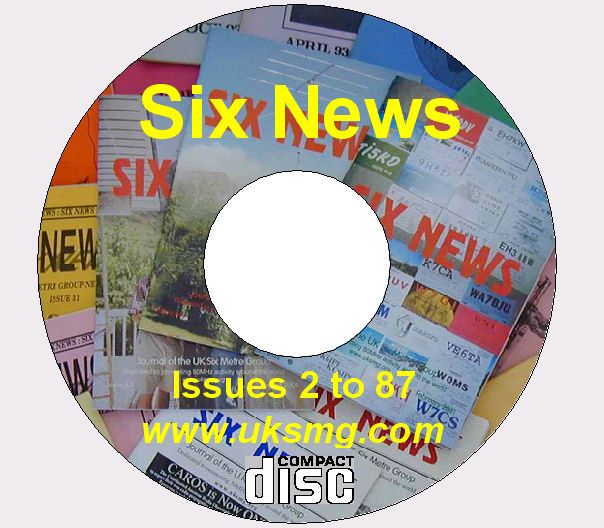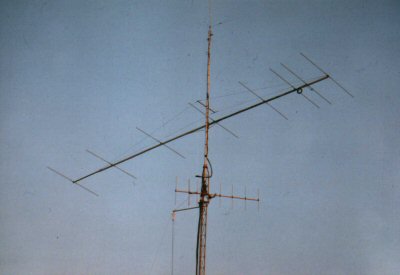

home > archive > interesting stuff > 50Mhz Moonbounce Using JT44

Thanks to all of our authors since 1982!
|
50MHz Moonbounce Using JT44 Ian Williams, M0BCG |
|
It wasn't actually going to be Lance I worked but I had a week of skeds with Barrie, W7ALW and on the Saturday at the end of the week his elevator packed up so he had to cancel the last sked on the Sunday night. Luckily, Lance W7GJ was operating that day and he said he'd call me after his three skeds with other EU ops (in OE, OK and ES) after they lost the moon. My moonset was some 30 minutes later so we had ample time to try a sked. I had had half a QSO with Lance a month before, but due to lack of moontime we didn't complete on that occasion. Of the week-long daily skeds with Barrie , W7ALW we made it to my sending RRRs to him on the Friday night but unfortunately he didn't hear them before the moon went below the horizon, hence no QSO.
How it was done Initially I ran my stack of two eight-ele yagis, but this greatly attenuated the higher lobes of the yagis' H-plane beam width and I didn't hear too much until the moon reached 10 degrees elevation. An EME sked QSO must be made within a one-hour time slot according to the IARU rules, and so I needed an aerial that would give me the best chance from a one-hour slot. I decided to make a radical change to my station in order to run the last two skeds on a single yagi, with which I could listen on the 2nd and 3rd lobes much better. So on the Friday night I designed a new eight-ele yagi on a 40-foot boom, with just a shade under 12dBd forward gain; this was to be run at 70 feet above ground. On Saturday I took down the stack and went about building the single eight-ele. I had it on the mast and working by 2000z that night, one hour before the sked with W7ALW.
I designed the eight-ele based on the fact that I had one day to build it before my next sked, and that was the only length I could go to without some serious fabricating of new trusses and boom. I ran a design up on my YA and YO programmes and evaluated them; I had a good clean pattern, especially in the rear of the H-plane, and about as much gain as I could squeeze out of it without losing a reasonable front to back ratio of 22dB. I checked the design at a height of 21.5m and it showed major lobes at about 4 degrees, 11 degrees and 22 degrees, with the higher lobe being around 2dB less gain than the major lobe. I thought maybe I could receive W7ALW and W7GJ on the 3rd lobe at the start of the sked and the when the moon went into my main lobe I could benefit from the ground gain it gave towards the end of the sked, the most crucial moment in my eyes. I had some trouble getting a good match but I changed around the driven element and first director spacings and changed the gamma match and then all was OK. I checked the dimension differences on my antenna programmes and there was no real difference, luckily. I ran the sked with Barrie and we didn't quite complete, but I thought the single yagi was doing a better job. A little later in to the night, after the sked, I put in line a pre-amp and set the receiver according to W7GJ Lance's specs, in the hope of lowering my noise figure for Sunday's final sked. Sunday came and I had problems with the brake on my rotator, so out came the rotator and into the workshop where it was repaired. Three hours later I was back up and running. When night came it was nice and clear, a lovely shot at the moon with nothing in between me and it. I went to the W7GJ sked frequency early and monitored it for an hour. I found I was hearing two of the EU operators calling Lance and also at 23 degrees elevation of the moon I heard Lance very clearly. The moon passed into my second lobe and I was hearing Lance very well. He finished his skeds with the other EU ops at 21:45z, after they lost the moon below the horizon, but I still had a good 45 minutes moontime left. Lance started calling me and almost immediately I was hearing him. I sent him OOOOOOOOOs for about 10 minutes and then I got RORORORORORO coming back from him. I sent RRRRRRRRRs for another 15 minutes; eventually I got the reply from him that I needed and the QSO was complete at 2224z. As soon as we'd completed the QSO I heard Lance starting to call George G4PCI, who had listened to my and various skeds on EME throughout the week using his single six-ele yagi, with astounding results too. We had arranged that if there was any moontime left George could run the rest of the time with W7GJ to see if they could make anything between them. George heard W7GJ calling him and responded with a set of OOOOOOs using just 100W; the moon was setting fast at this time however and already had reached three degrees elevation. Lance managed to get a slight trace up on his SPECTRAN display from G4PCI and also received a brief part of the message sent by George on his JT44 display, but unfortunately he didn't decode it fully. The moon then disappeared below the horizon and the rest is history. G4PCI has been hearing some good stuff on EME using a single six-ele yagi. He does have a low noise environment to the west, but it does show just what can be done on this mode if you set up for it carefully. It's a pity I did not complete with Barrie W7ALW and also that we didn't have more moon time for G4PCI to call W7GJ for longer. Unfortunately the next day Lance W7GJ had to go into hospital for an operation and he was due to be inactive for a few weeks or so. That meant that G4PCI and W7GJ couldn't run a sked at moonset the next day to see if a QSO could be made using 100W from this side of the Atlantic .
Equipment My equipment for the QSO consisted of a single, gamma matched, eight-ele yagi on a 40 foot boom - 11.9dBd, 22dB front/back – at 70 feet height above ground. The transceiver was an IC756 with internal pre amp #1 only switched on and an external 20dB (1db noise figure) pre amp in line after the transceiver, giving about 10dB of extra gain. All filters were set as wide as possible on SSB and the AGC was OFF. The rig PTT interface is a RIGBLASTER PLUS from West Mountain Radio. The amplifier I used was my spare Heathkit SB220 (circa 1969) which I have converted for HF and 50MHz coverage. This amp has a lot of mods and is cased in a solid steel case, with valve base venting and also three extra cooling fans above the RF deck to draw out the heated air and allow the necessary duty cycle for JT44 operation (30 sec tx-30sec rx ) at the legal UK power limit running on the lower HV setting of 2250V. Coax is a mixture of Heliax LDF-250A and LDF550-A, with total coax losses of around 0.85dB. I use an ICE426N low pass filter and a coaxial stub filter for the 100MHz harmonic and amp safety.
Summary I think this was the first ever UK JT44 50MHz EME QSO made on this digital mode, although if anyone has made a QSO before me I stand corrected. Anyone else thinking of running this mode for six-metre EME should give it some serious thought. This QSO was enabled really by the fact that Barrie, W7ALW and Lance, W7GJ were keen enough to run skeds with me for the whole week; without both their efforts, the QSO would not have been made at this time. Barrie runs 4 x 7 ele M2 yagis and Lance runs 4x 9 ele yagis of his own design (I think). They live 25 miles apart in deepest, darkest Montana , but Montana isn't quite so dark for six metres now and Lance is making some good gains using JT44 on 50MHz EME. If anyone wants to just try receive on this mode, a good six-ele yagi will hear W7GJ under good conditions. I don't know if its of interest to all six metre men, but it took me seven years of building up my station, followed by two days of radical change and a big gamble, to make this, my first EME QSO on six metres. There has to be much praise given to Joe K1JT, whose WSJT FSK441 & JT44 modes have made such a technical advancement, I think, in six metre EME working. I have tried a couple of CW EME skeds but have had limited success on running with a two-yagi array; this JT44, however, is a completely different kettle of fish. By doing what I did I hope it brings home that many six metre operators will now be able to make an EME QSO on this band without having to run kilowatts of power and very large arrays.
|
CQ from UA2F/DK2ZF
Lebanon on 6m
Bermuda on 50mhz - June
1994
who are those NA stations?
6m is dead, so what?
the UK six metre
repeater network
of mice and men - /p
in EI
sic metres - the
tragic band?
F2 DX opening cycle 22,
11 Feb '89
european
beacon map
prototype
time-sharing multi-band beacon
The story of PA3HEN/MM
are you one of the
deserving?
an interview with
Peter Sprengel, PY5CC
some
statistics of activity by XE stations
the wide route
along the equator
a homebrew contest station
the Hong Kong 6m scene
a new 6m bandplan
JT44 for DXCC?
